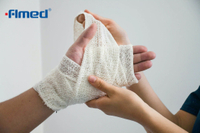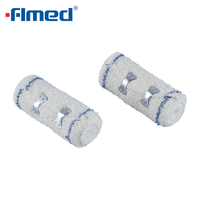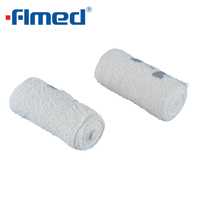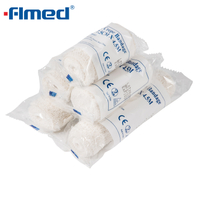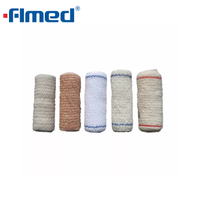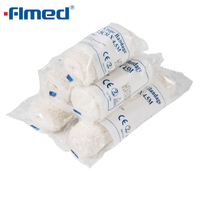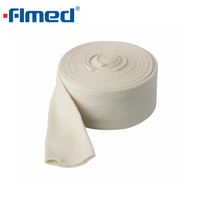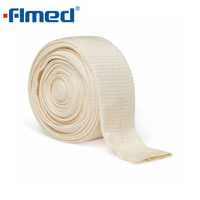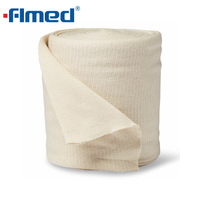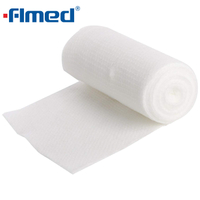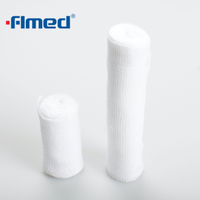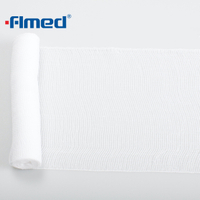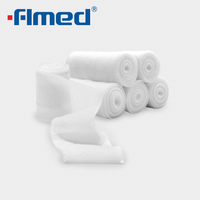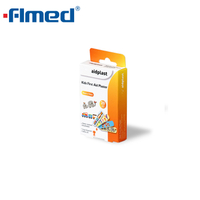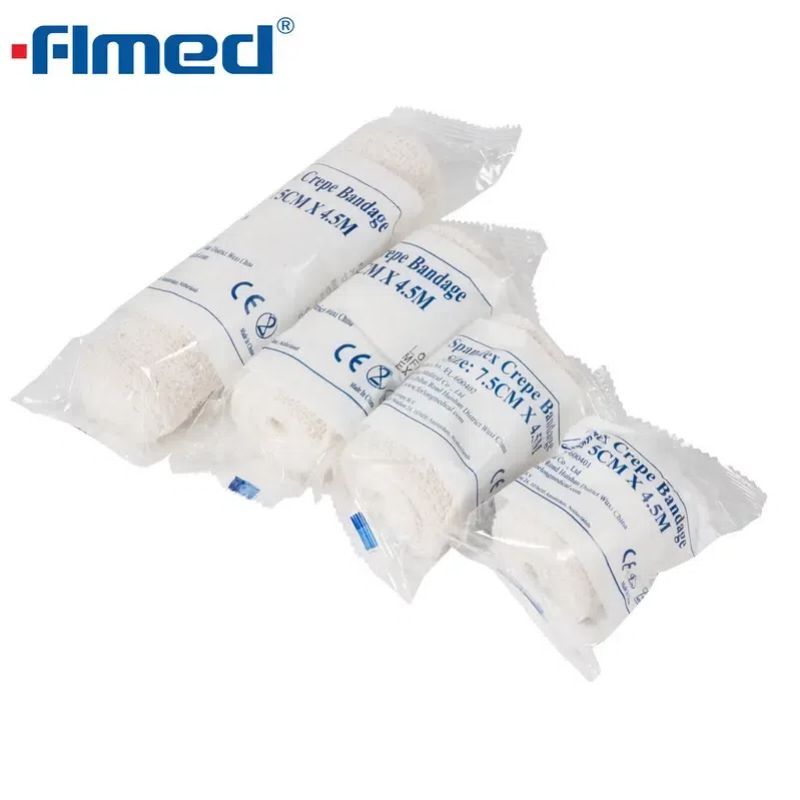
Plaster of Paris bandages are an essential tool in modern medical care, offering rigid support for injured limbs and fractures. Forlong Medical provides a wide range of high-quality medical bandages, including plaster of paris bandage, crepe bandage, and high elastic bandage, ensuring safety and reliability for professional use. Understanding how these bandages work, their clinical applications, and proper handling is key for healthcare providers and suppliers alike. Beyond immobilization, these bandages also play a crucial role in patient comfort, reducing movement that could worsen injuries.
What is a Plaster of Paris Bandage?
Plaster of Paris bandages, often referred to as POP bandages, are strips of fabric impregnated with plaster of Paris, a fast-setting material composed primarily of calcium sulfate hemihydrate. When the bandage comes into contact with water, a chemical reaction occurs — the calcium sulfate reacts with water to form gypsum (calcium sulfate dihydrate). This exothermic reaction allows the bandage to harden quickly, creating a rigid cast that immobilizes the injured area.
The unique property of POP is its ability to conform to the shape of the limb while maintaining structural strength once set. This makes it ideal for immobilizing fractures, sprains, and other musculoskeletal injuries. The plaster penetrates the fibers of the bandage, ensuring even setting and maximum support, while the lightweight nature of the bandage allows for patient comfort and ease of handling. Additionally, POP bandages provide a smooth surface for later padding and external splinting accessories, making them compatible with other medical support tools such as PBT bandage and cohesive wraps.
Clinical Uses and When a POP Bandage is Appropriate
Plaster of paris bandages are primarily used for immobilizing fractures and providing temporary support during transport or treatment. They are commonly applied in the following situations:
Fracture immobilization: POP bandages maintain the alignment of broken bones to prevent further injury and facilitate proper healing.
Splinting during transport: Emergency responders often use POP bandages to stabilize injured limbs while moving patients to medical facilities.
Temporary casts: In cases where immediate surgical intervention is not possible, POP casts provide a temporary solution until definitive treatment is administered.
Corrective orthopedic procedures: Some mild deformities or post-surgical recovery situations also benefit from the controlled rigidity of a POP cast.
It is crucial to note that POP bandages should always be applied by trained healthcare professionals. Incorrect application can lead to complications such as pressure sores, restricted circulation, or improper fracture healing. Forlong Medical’s POP-compatible supplies are designed to meet rigorous quality standards, ensuring reliable performance in professional settings. Proper training and adherence to safety guidelines maximize the effectiveness of POP bandages and protect patients from additional harm.
![Bandage Bandage]()
Step-by-Step: How a Professional Prepares and Applies POP Bandages
Applying a plaster of paris bandage involves several carefully coordinated steps to ensure patient safety and optimal results.
Preparation: Healthcare providers begin by selecting the appropriate size and type of bandage. The area to be casted is cleaned, and soft padding is applied to protect the skin. Forlong Medical offers high-quality padding materials that complement POP bandages to enhance comfort and reduce the risk of skin irritation.
Soaking the bandage: POP bandages are soaked in lukewarm water until fully saturated. Excess water is gently squeezed out to prevent dripping while maintaining sufficient moisture for the plaster to set. This step is essential to achieve a smooth, even cast without cracks or uneven hardening.
Molding and application: The bandage is wrapped around the affected area, with careful attention to shape and alignment. Providers mold the bandage to the contours of the limb to ensure a snug fit and effective immobilization. Skilled professionals may use additional layers to increase strength, especially for weight-bearing areas like wrists or ankles.
Drying time: Once applied, the cast begins to harden within minutes. Full strength is achieved over several hours, depending on environmental factors such as temperature and humidity. During this period, patients are advised to keep the cast undisturbed to avoid deformities or weak points.
Signs of Improper Fit to Watch For
Improper application can compromise the effectiveness of a POP bandage. Healthcare professionals watch for the following signs:
Excessive tightness or numbness in the fingers or toes
Uneven setting or cracks in the cast
Persistent pain or swelling beyond initial trauma
Skin discoloration, which may indicate restricted blood flow
Recognizing these indicators early ensures timely adjustment and prevents complications. Forlong Medical also provides comprehensive product guides and MSDS documentation, which assist medical staff in evaluating the safety and proper handling of POP bandages.
Safer Alternatives for Home Care
While POP bandages provide rigid support, they are not suitable for home application due to the risk of improper handling. For at-home care, patients can use safer alternatives such as compression bandages, high-elastic bandages, or crepe bandages. These options provide support and reduce swelling without requiring professional expertise.
Compression and conforming bandages are ideal during the recovery phase after the removal of a POP cast. They maintain stability, improve circulation, and prevent further strain on healing tissues. Forlong Medical offers a variety of crepe bandage and high elastic bandage options that are easy to apply, breathable, and designed for everyday use in home care or post-treatment support. Furthermore, PBT bandage is particularly effective for long-term support, offering both flexibility and mild pressure to reduce post-injury swelling while ensuring comfort.
Shipping, Storage, and Quality Checks for POP Bandages
For suppliers, maintaining the quality of POP bandages requires careful attention to storage and handling:
Packaging: Bandages should be sealed in moisture-resistant packaging to prevent premature setting. Quality packaging also reduces the risk of contamination during shipping.
Storage: A cool, dry environment ensures the bandages retain their usability. Exposure to high humidity can activate the plaster and reduce shelf life.
Expiry and certification: Reputable suppliers, like Forlong Medical, provide clear expiry dates and quality certifications. Buyers should request specifications and MSDS sheets to verify compliance with safety standards.
Quality checks: Before distribution, each batch should be inspected for uniform impregnation, consistent thickness, and proper setting time. This ensures that every POP bandage performs as expected in clinical use.
These measures guarantee that POP bandages arrive in optimal condition and perform reliably in clinical settings, maintaining both safety and patient confidence.
Product Highlight: Our POP-Compatible Supplies and Support
Forlong Medical provides a comprehensive range of POP-compatible products. Our catalog includes plaster of paris bandage, crepe bandage, high elastic bandage, and PBT bandage, catering to various clinical and emergency needs. We also offer complementary items such as padding and cohesive wraps to ensure patient comfort and proper cast application.
Technical support is available to guide medical professionals and suppliers on best practices, including storage, handling, and application tips. This integrated support helps healthcare providers deliver safe, effective care while maximizing the benefits of POP bandages. By selecting our products, clinics and hospitals ensure access to reliable, high-quality materials that meet both clinical and regulatory standards.
Conclusion
Plaster of paris bandages are indispensable in modern medical care, providing rigid support for fractures and injuries. Using them safely requires professional application, proper preparation, and high-quality materials. Forlong Medical’s range of bandage products, including plaster of paris bandage, crepe bandage, high elastic bandage, and PBT bandage, ensures reliable performance for healthcare providers worldwide. For detailed specifications, technical guidance, or to explore our full catalog, contact us today to discover how our medical supplies can meet your professional needs and support safe, effective patient care.

 English
English
